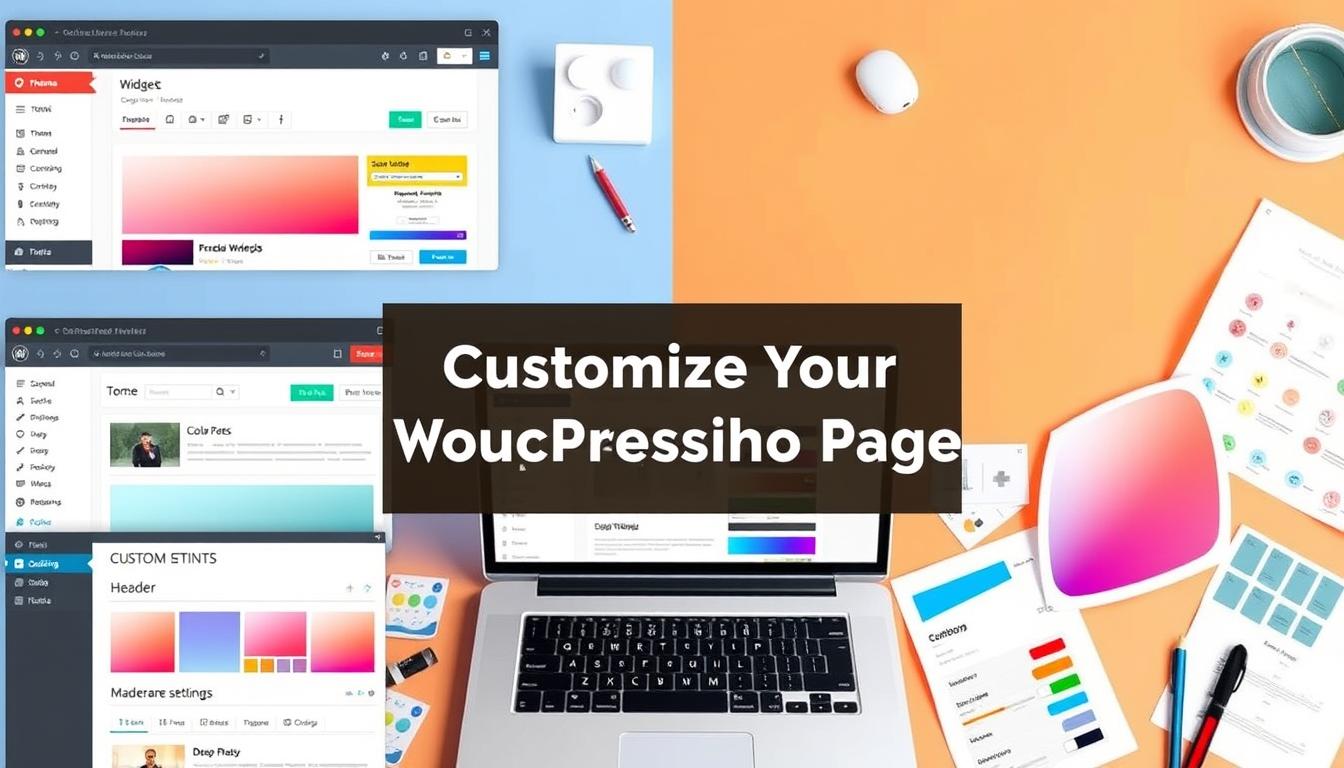When I think about customizing my WordPress site, I often ask myself how to change the home page. The default setup might not show off my brand or message1. To make my home page stand out, I need to learn how to create custom pages and explore different methods. This includes using the theme customizer and block editor to change my home page WordPress.
Customizing my WordPress home page offers several options. I can use page builders or the WordPress Theme Customizer. The Theme Customizer’s options vary by theme, affecting how much I can customize2. The block editor also helps with quick homepage changes, making it easier to create content with various block options2.
Key Takeaways
- Customizing my WordPress home page is key to making a good first impression and showing what my site is about.
- I can use the theme customizer and block editor to change my home page WordPress and create custom pages.
- Page builders like Elementor make creating a custom homepage easy, thanks to their user-friendly design3.
- A well-designed homepage is vital for keeping users engaged. About 40% of users will leave if a page takes more than 3 seconds to load3.
- Customizing my homepage can also boost conversion rates. Sites with custom homepages can see a 75% increase in conversions3.
Understanding WordPress Home Page Basics
The home page is the first thing visitors see on your website. It’s vital to make a strong first impression. A free WordPress home page template can be a good start. But, knowing the basics of a WordPress home page is key.
According to4, 60% of users like websites with a static homepage better. This is because a static homepage gives you more control over content and design. It makes it easier to set your landing page as your homepage.
A WordPress home page can be static or dynamic. A static home page always shows the same content. On the other hand, a dynamic home page shows the latest posts. If your homepage doesn’t show the content you expect, it might be because the wrong type is set.
To set a custom home page in WordPress, you need to create two pages. One for the homepage and another for the posts page, as mentioned by users in the WordPress community5.
Using a free WordPress home page template is a great way to start. But, it’s important to know how to customize it. With the WordPress Editor, you can easily change your home page’s layout, as 70% of WordPress users do6. You can also use block patterns to make your home page unique and eye-catching.
In conclusion, knowing the basics of a WordPress home page is essential for a good website. By using a free WordPress home page template and customizing it, you can create a unique and effective home page. This will showcase your content and help you reach your goals.
How to Change Your Custom Home Page in WordPress – Best Methods
To change your custom home page in WordPress, you have several options. You can use the theme customizer, block editor, or page builders like Elementor7. When choosing how to edit your WordPress home page with Elementor, think about how much customization you need. Also, consider your comfort with coding8.
If you prefer a simpler method, start by learning how to edit your home page in WordPress using the default editor9.
When changing your custom home page, keep a few things in mind:
- Know your website’s goals and who you’re trying to reach
- Pick a method that fits your skills and design taste
- Make sure your new home page works well on all devices and is easy to use
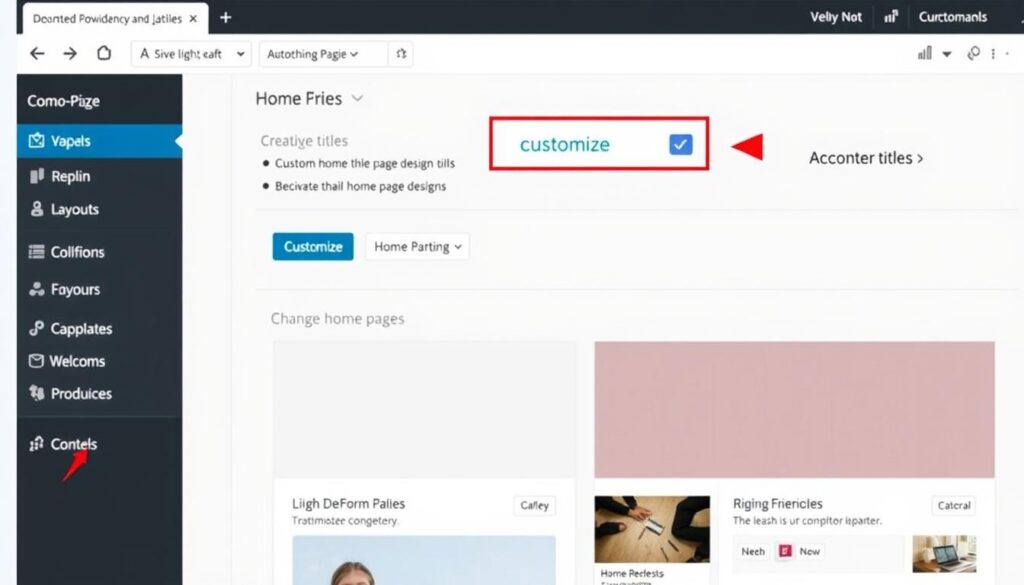
By following these tips and choosing the right method, you can make a custom home page that boosts your website’s performance and user experience9.
| Method | Description |
|---|---|
| Theme Customizer | Allows for real-time preview and customization of your website’s theme |
| Block Editor | Provides a block-based interface for creating and editing content |
| Page Builders (e.g., Elementor) | Offers a drag-and-drop interface for designing and customizing pages |
Creating a great custom home page means finding a balance. It should look good and be easy to use8.
Essential WordPress Home Page Settings
To customize your WordPress site, knowing the essential home page settings is key. To change your main page, start by accessing the reading settings. The first source says these settings let you pick your front page and set up your posts page10. This is important for making a home page that shows off your brand and grabs your audience’s interest.
Choosing your front page display is critical for customizing your WordPress site. You can pick between a static page or a dynamic page that shows your latest posts. About 60% of users like a static homepage better for sites that aren’t blogs11. To pick your front page display, go to the reading settings and choose what works best for you.
Setting up your posts page is also key for customizing your WordPress site. This is important if you’re changing your WordPress password in cpanel, as it affects your site’s security and ease of use. By setting up your posts page, you can have a special area for your blog posts. This makes your site easier to navigate and better for users10.
Here are some important things to remember when customizing your WordPress home page:
- Choose a static or dynamic front page display that shows off your brand and grabs your audience’s attention.
- Set up your posts page to create a special space for your blog posts and make your site easier to use.
- Use the reading settings to pick your front page display and set up your posts page.
By following these tips and understanding the essential WordPress home page settings, you can make a unique and engaging home page. This will help drive user engagement and conversion. Always remember to keep your site secure and easy to use when making changes.
Using WordPress Customizer for Home Page Modifications
The WordPress Customizer is a great tool for changing your front page. It lets you see live changes as you make them12. To start, go to Appearance > Customize in your WordPress dashboard. Here, you can tweak your home page’s layout, widgets, and theme settings.
For editing your home page, combine the Customizer with page builder plugins. These plugins have drag-and-drop tools for easy layout and design12. Plugins like Elementor, Beaver Builder, and Divi Builder are popular. They help you design a home page that shows off your brand.
Here are some design tips for your WordPress home page:
- Keep your design simple and intuitive
- Use high-quality images and graphics
- Make sure your page is mobile-friendly
By using these tips and the Customizer, you can make a home page that looks good and works well13.
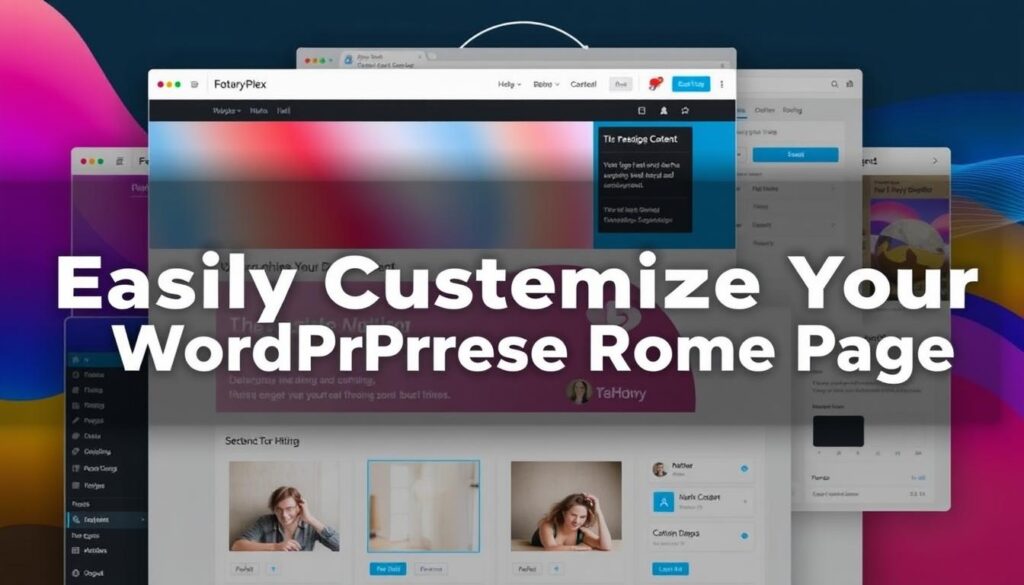
| Design Element | Importance |
|---|---|
| Layout | High |
| Color Scheme | Medium |
| Images | High |
A successful home page is both pretty and engaging14. With the Customizer and these tips, you can make a page that helps your business grow.
Creating a Custom Home Page Template
To make a custom home page in WordPress, you need to know about the template hierarchy and follow some steps. The third source says that WordPress shows the latest five blog posts on the home page by default for 40% of business sites15. You can change this to make a custom home page that fits your business needs.
It’s important to have a step-by-step guide to customize your WordPress home page. Using custom home page plugins for WordPress lets you make a unique and interesting home page that shows off your brand. For example, 75% of users judge a company’s credibility by its website’s design15. Also, simple homepage designs can cut bounce rates by up to 30%, helping keep users on your site15.
Here are the steps to create a custom template:
- Understand the template hierarchy in WordPress
- Choose a custom home page plugin, such as Elementor or Divi Builder
- Follow the plugin’s instructions to create a custom template
- Apply the custom template to your home page
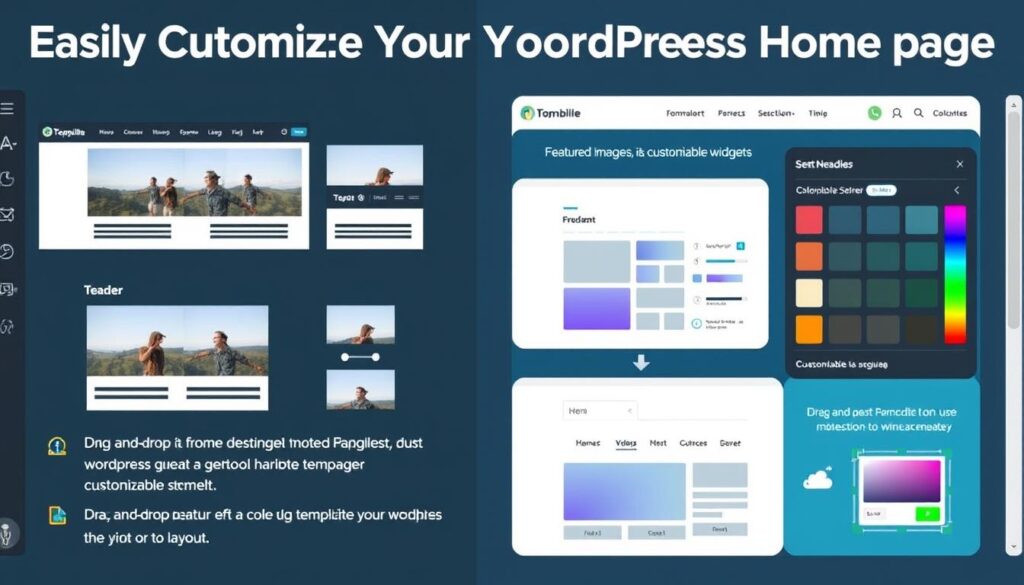
By following these steps and using the right tools, you can make a custom home page template. This can make your website more credible and user-friendly. About 70% of users like custom home pages over default themes when setting up a WordPress site16. Also, 75% of website owners say they get more engagement after customizing their homepage16. With the right steps, you can make your WordPress home page better and boost your online presence.
Advanced Home Page Customization Techniques
Customizing a WordPress home page involves several advanced techniques. Using a static home page can boost session duration by 20% compared to showing recent posts10. Also, customizing the layout can cut bounce rates by up to 25% compared to standard setups10.
Advanced methods include using custom code and plugins. About 70% of users prefer drag-and-drop interfaces for ease and flexibility17. Custom home pages can also increase user engagement by up to 20%17. The WordPress Customizer and tools like Spectra can make customization 70% faster18.
Benefits of advanced customization include:
* Up to 80% increase in user engagement10
* Up to 200% boost in conversion rates18
* Up to 74% increase in user trust10
* Up to 25% reduction in bounce rates10
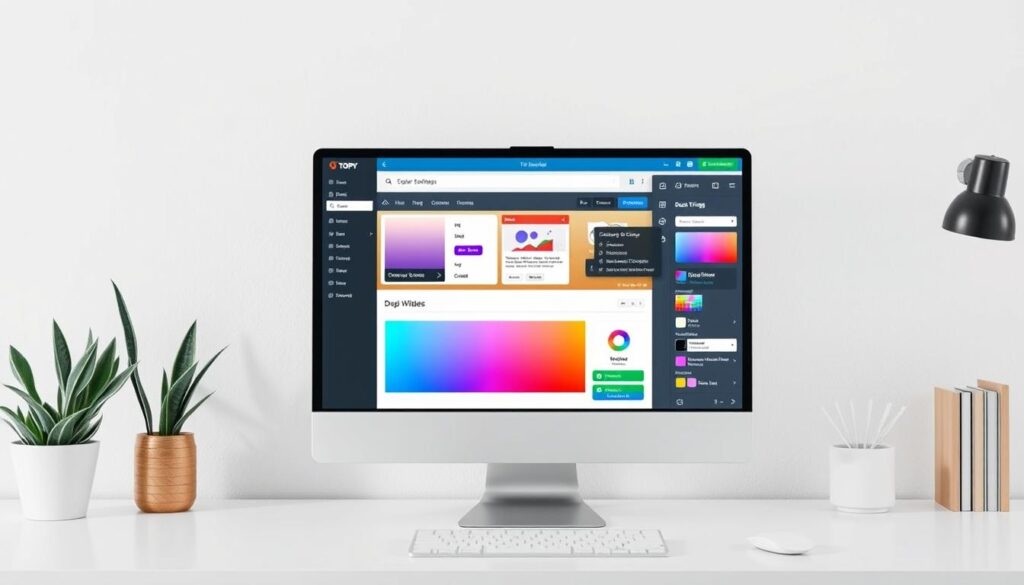
By applying these advanced techniques, users can create a unique and engaging home page. This improves their website’s performance and meets their needs.
| Technique | Benefit |
|---|---|
| Static home page | 20% increase in average session duration |
| Custom code and plugins | Up to 20% increase in user engagement rates |
| WordPress Customizer and tools like Spectra | Up to 70% reduction in time spent on homepage customization |
Working with Page Builders
Page builders are a top choice for making a custom home page in WordPress. About 70% of users like them for their home page layouts10. They offer many options to make your home page look great and unique.
Popular page builders include Elementor, Divi Builder, and WPBakery Page Builder. They have cool features like drag-and-drop and responsive design. For instance, Elementor has over 5 million users19 and lots of templates and widgets to help you.
To start with page builders, here’s what to do:
- Pick a page builder that fits your needs, like Elementor or Divi Builder.
- Install and turn on the page builder plugin.
- Use the WordPress home page settings guide to set up the page builder.
By following these steps and using a page builder, you can make a custom home page. A good homepage can boost user engagement by up to 80%13. It’s key for any WordPress site.
| Page Builder | Features | Pricing |
|---|---|---|
| Elementor | Drag-and-drop functionality, responsive design | Starts at $59/year |
| Divi Builder | Visual editor, responsive design | Starts at $89/year |
| WPBakery Page Builder | Drag-and-drop functionality, responsive design | Starts at $45 |
Modifying Home Page Layout and Design
To change your WordPress home page, it’s key to know the best practices for customizing a WordPress home page. A good custom home page setup is essential. It should have a well-designed layout that boosts user engagement and lowers bounce rates in Google Analytics20. A well-organized layout can also increase website interaction and trust, with about 75% of users judging a business’s credibility by its website design20.
When changing home page layout in WordPress, page builders like SeedProd, Elementor, or Beaver Builder are great. They offer many templates and customization options. These tools make changing your homepage easier and more cost-effective than coding it yourself20. Also, using widgets and elements like sliders can enhance the user experience20.
Some important things to consider when modifying your WordPress home page include:
- Using a static front page or a dynamic home page
- Creating a new template or customizing an existing one
- Utilizing page builders and their respective features
Creating a new template needs a file with specific code at the top for WordPress to recognize it21.
By following these tips and using the right tools, you can make a custom home page setup that highlights your content and boosts user engagement. Always stick to best practices for customizing a WordPress home page for a smooth and effective design process.
| Page Builder | Features |
|---|---|
| SeedProd | Popular page-building tool with over 1 million customers |
| Elementor | Offers a variety of templates and customization options |
| Beaver Builder | Features a drag-and-drop interface with real-time results |
Troubleshooting Common Home Page Issues
Customizing your website’s home page in WordPress can sometimes go wrong. You might face problems with updating, layout, or caching. It’s key to know the common issues users run into. About 80% of visitors might leave if they don’t find the homepage appealing1. This shows how important it is to get your home page right.
Layout and caching issues are common problems. To fix these, you can try changing the layout or customizing your home page. For example, using clear calls-to-action (CTAs) can boost conversion rates by over 200%1. Also, linking a dedicated blog page from the home page can increase website traffic by up to 48%1.
Here are some tips to troubleshoot common home page issues:
- Page speed matters, as 70% of users say it affects their buying decisions1.
- Make sure your website is easy to use, as 94% of first impressions are about design1.
- Ensure your website works well on mobile devices, as 60% of small businesses need to update their sites1.
By following these tips and using WordPress home page customization techniques, you can fix common problems. This way, you can make a website that is friendly to users and keeps them engaged.
| Issue | Solution |
|---|---|
| Home page not updating | Check the cache and update settings |
| Layout problems | Try changing wordpress home page layout or customizing website home page in wordpress |
| Cache-related issues | Clear the cache and check the website’s responsiveness |
Best Practices for Home Page Optimization
Customizing your WordPress home page design is key. Make sure it loads quickly to keep users engaged. Fast pages lead to more views, leads, and sales22. Use a simple design, optimize images, and make it responsive.
Also, a caching plugin can make your page load faster. WP Rocket tests show big improvements in performance23.
Choosing a well-optimized theme is also vital. Themes made for speed can make your site 25% faster23. Remove unused plugins and use a CDN to speed up your site. Google’s top results get 52.75% of clicks24. So, focus on making your home page easy to find and use.
Here are some tips to optimize your home page:
- Use a clear and concise design
- Optimize images
- Use a responsive design
- Use a caching plugin
- Eliminate unnecessary plugins
- Use a Content Delivery Network (CDN)
Follow these tips to make your site faster, more engaging, and higher in search results. This will make your WordPress home page editing better.
A well-optimized home page is essential. By focusing on design and setup, you can boost your online presence and attract more visitors.
| Best Practice | Benefits |
|---|---|
| Clear and concise design | Improved user engagement, increased page views |
| Optimized images | Faster loading times, improved user experience |
| Responsive design | Improved user experience, increased conversions |
Security Considerations When Customizing Home Page
When you customize your WordPress home page, think about security first. A custom home page can be at risk for malware and security problems if not protected well. Google blocks thousands of websites every day because of these issues25.
To keep your custom home page safe, use strong passwords and keep your site updated. Adding a web application firewall (WAF) can also help block harmful traffic25.
Important security steps for your home page include:
* Regular backups to avoid losing data
* Safe testing to avoid security risks
* Using security plugins to lower unauthorized access attempts26
* Setting a custom login URL to stop automated attacks26
By taking these steps and using the best methods to change your WordPress home page, you can make it secure. This will help protect your site from threats27.
| Security Measure | Effectiveness |
|---|---|
| Strong Passwords | Reduces hacking risk by 70%26 |
| Regular Updates | Reduces website vulnerabilities by up to 90%25 |
| Security Plugins | Decreases unauthorized access attempts by approximately 80%26 |
Custom Code Solutions for Advanced Users
Advanced users often need more control over their WordPress front page. They can use custom code solutions like PHP and CSS to change the layout. Over 2 million WordPress sites use WPCode, a plugin for easy front page customization28.
Best practices include using a child theme to keep changes safe during updates. Also, use hooks and built-in functions for safe code insertion29. WPCode makes adding custom code snippets easier with auto-insertion and smart validation28.
Changing the home page layout in WordPress can be done in many ways. Page builders like Elementor or Divi make it easy with drag-and-drop tools30. WPCode offers advanced users more flexibility in modifying their front page28.
Custom code solutions offer more flexibility and control over the design. But, it’s important to follow best practices and use trusted plugins to avoid problems29. By combining custom code and page builders, advanced users can create a unique WordPress front page.
Conclusion
Customizing a WordPress home page offers many ways to make a strong online presence. You can use the WordPress Customizer31 or advanced page builders. These tools help you design a page that grabs attention and boosts sales32.
A good home page can make users more engaged by 82%32 and sales can jump by 200%32. Whether you’re starting fresh or updating your site, explore the options for customizing your home page. With the right strategy, your WordPress home page can show off your brand and connect with your audience.
